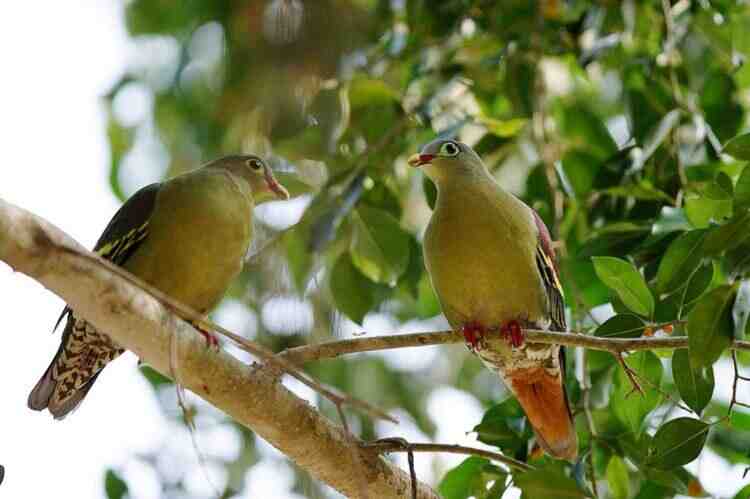reron curvirostra
IUCN
LCBasic Information
Scientific classification
- name:reron curvirostra
- Scientific Name:Rough-billed Green Pigeon,Treron curvirostra,Thick-billed Green Pigeon
- Outline:Landfowl
- Family:Columbiformes Columbidae G.Pigeon
Vital signs
- length:21.5-28.5cm
- Weight:105-222g
- lifetime:About 16 years
Feature
The bill is short and thick, pale yellowish green or lead white
Distribution and Habitat
Existing (breeding grounds): Philippines and Singapore.
Existing: Bangladesh, Bhutan, Brunei Darussalam, Cambodia, China, India, Indonesia, Lao People's Democratic Republic, Malaysia, Myanmar, Nepal, Thailand and Vietnam.
Existing and wandering: Hong Kong, China.
In China, it is distributed in Wuzhishan, Hainan, Longzhou and Tiandeng, Guangxi, Xishuangbanna, Yunnan, etc.
Thick-billed green pigeon is a resident bird. It likes to live in dark and humid primeval forests, evergreen broad-leaved forests and secondary forests in tropical and subtropical mountainous hills. It is mostly active in the morning and evening and likes to live on the top of dead branches.
Appearance
The Thick-billed Green Pigeon is about the same size as a domestic pigeon. It has a short and thick beak that is light yellow-green or lead-white. The sides of the beak base are coral red, the feet are also coral red, and the claws are horn brown. The iris inside the eye is divided into two circles, the outer circle is orange-red, and the inner circle is gray-blue, which is very unique. There is also copper-green bare skin around the eye. The male bird's feathers are slightly gray from the forehead to the top of the head, the back is dark chestnut red, the wings are black, and there are bright yellow wing bands. The central tail feathers are olive green, and the lower part is gray-brown with gray tips. The tail feathers are black except for the two central feathers that are light brown. The coverts on the flanks, legs and anus are dark green, mixed with white spots, and the coverts under the tail are cinnamon.
The female bird is similar to the male bird, but the back is not dar
Details
Thick-billed Green Pigeon, also known as Thick-billed Green Pigeon, has 9 subspecies.

Thick-billed Green Pigeon is fond of eating the fruits of banyan trees, so it often appears in fruit trees, especially banyan trees. Places with abundant old banyan trees often attract a large number of Thick-billed Green Pigeons, which may even settle in the forest. Dozens or even hundreds of Thick-billed Green Pigeons often gather on a banyan tree, among which there are often pintail Green Pigeons, yellow-footed Green Pigeons, and even starlings, silk-light starlings, blackbirds and other birds that love to eat tree fruits. Thick-billed Green Pigeons often make noisy calls when eating, or "coo, coo" like a child crying, or like a melodious whistle. In places where there are no banyan trees, such as near villages and evergreen broad-leaved forests on hills, they also eat fruits and seeds of other plants. After a full meal, they hide in the tree to rest, and leave the foraging area at dusk to spend the night in the deep forest.
Thick-billed green pigeons breed from April to September every year. When courting, the male bird puffs up its throat and chest, with its wings drooping, and wanders around the female bird, or nods rapidly and repeatedly, and gently makes whistling calls. At this time, the female bird is also very excited and dances with the male bird. The male and female birds build nests together, but the female bird bears more work, and the male bird often goes out to find food for the female bird. The nest is built in the leaves of small trees, shrubs or bamboo forests in the forest, or on branches where branches intersect with each other. Some nests are also built in dense bushes entangled with vines. They are generally 2-3 meters above the ground, but there are also lower and higher nests of more than 9 meters. Their nests are mainly made of thin dead branches or straw piles. They are very simple, and the eggs in the nest can even be seen from below, but the parents and hatched chicks will not fall out of the nest. Thick-billed green pigeons are very protective of their nests, and often fight during nesting, so it is rare to see two nests close together. Thick-billed green pigeons are even more determined to attack other birds that invade their nesting areas. They usually lay two white, smooth eggs per nest. The incubation period is about 14 days, and the male and female birds take turns to incubate and raise the chicks.
Listed in the "National List of Terrestrial Wildlife with Important Economic and Scientific Research Values under State Protection" issued by the State Forestry Administration of China on August 1, 2000.
Listed in the "Red List of Endangered Species of the World Conservation Union" (IUCN) 2018 ver 3.1-Least Concern (LC).
Listed in the second level of the "List of National Key Protected Wildlife in China".
Protect wild animals and eliminate game.
Maintaining ecological balance is everyone's responsibility!








